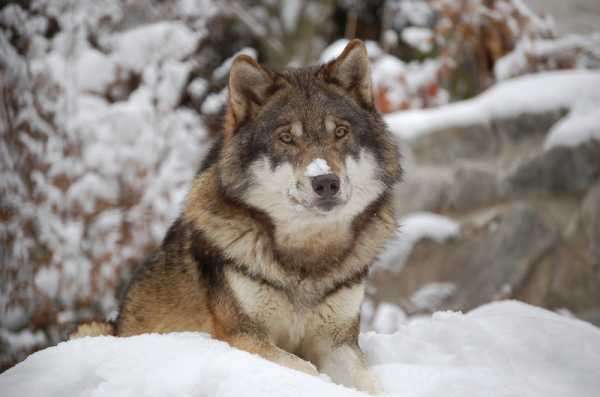
For the umpteenth time, moves are afoot to try to convince the European Commission to remove strict protections for wolves (Photo: Caninest)
Wolves get a bad rap.
Throughout history, this native species has been reviled and seriously misunderstood, which ultimately led to their extermination from many parts of Europe between the 18th and mid-20th centuries.
In popular culture, wolves were routinely incarnated as evil villains in fables and fairy tales. The cliché of the big bad wolf continues into the present day. In some places, like Finland, where wolves have survived, deeply entrenched cultural anxieties about the species fuel unfounded fears that they will attack innocent children on their way to school.
The truth is that wolves are more scared of us than we should be of them. Moreover, they should be scared. Very scared.
For the umpteenth time, moves are afoot to try to convince the European Commission to remove strict protections for wolves.
The European Parliament’s AGRI Committee has drafted an abysmal resolution calling for action, despite the fact that they had already been told – in no uncertain terms – by the parliament’s ENVI committee that this issue did not fall under their competence. This draft resolution will be debated on Monday afternoon (10 January).
It is happily the case that some, but not all, wolf populations in Europe have achieved a favourable conservation status. Legislative action, such as the EU Habitats Directive, and international coordination efforts, including the Bern Convention, have led to the return of wolf populations in parts of Europe, and a few individual wolves have recolonised their historic habitats on their own.
We cannot, however, assume from this that the outlook for wolves is great. It is crucial that protections remain in place to ensure that their favourable status is not compromised. Their survival is still threatened by habitat degradation and fragmentation, extensive poaching, as well as low social acceptance among some interest groups, particularly the animal farming industry.
In a highly-populated continent like Europe, large carnivore conservation requires coordinated integration with human activities in human-dominated landscapes.
In some member states, lack of natural prey, habitat loss and unprotected livestock contribute to large carnivores’ attacks on domestic animals, whilst in others, conflict lies in wild prey competition with humans as well as the public’s fear of coexisting with large predators.
Good for the ecosystem
At its most preposterous, the draft AGRI resolution suggests that the wolf gaining a favourable conservation status in some regions of Europe would disturb the natural balance of the ecosystem. Wolves are actually good for ecosystems, because they regulate the population densities of wild ungulate species and, in reality, remove fewer of these animals from the wild than human hunters do.
In recent years, significant societal debate about how to mitigate and prevent human-wolf conflicts has produced regulatory measures to effectively mitigate wildlife conflicts and help humans to successfully coexist with large carnivores in the long term.
Scientific studies have also demonstrated the inefficacy of lethal control, suggesting that AGRI is simply stuck in the past when it comes to constructive action here.
Given that wolves are listed in the annexes of the EU Habitats Directive as either a strictly-protected or protected species, depending on the population in question, hunting permits to kill them can only be granted under exceptional circumstances.
The directive authorises member states may use derogations to allow management control provided there is “no satisfactory alternative and the derogation is not harmful to the maintenance of the populations of the species concerned.”
These exceptions are meant to stop “serious damage” to livestock and crops, protect the public’s health and safety or for research and education. However, they cannot be used to authorise indiscriminate slaughter of wolf populations. The EU Commission also recently published a guidance document to clarify how this derogation can be applied.
Regrettably, our vision of the natural world is all too often clouded by anthropocentrism. Rather than taking recourse to rifles because there are more wolves around, we must learn to coexist with these large carnivores – at some level, we owe it to them.
To prevent their extinction or fragmentation of their populations (resulting in inbreeding), we must be willing to share habitat and tolerate the relatively low risk that native carnivores pose.
There is also strong scientific evidence that lethal control is the least effective way to reduce livestock depredation, largely because it disrupts the wolf pack structure and leads the remaining animals to exploit easy prey, such as farm animals.
This is, of course, a hard pill for farmers to swallow. It looks simpler to lethally eliminate a predator than to implement non-lethal mitigation measures, such as the installation of electric fences, use of guard dogs and the deployment of intervention experts, to reduce conflicts and protect herds in problematic areas.
The EU’s LIFE programme has funded numerous projects to help effectively mitigate human-large carnivore conflicts.
State aid provisions compensate farmers with 100 percent financial remuneration for losses suffered and costs incurred by predator attacks, but also offer 100 percent reimbursement for the mitigation measures implemented.
For this and other reasons, taking an ‘ecocentric’ view of the world, rather than human-centred one, and striving for coexistence is our best way forward.
Source: euobserver.com



